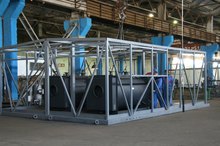Safety Information for Benzoic Acid
Benzoic acid is found both naturally, in foods such as berries and milk products, and as an added preservative in processed foods such as baked goods, candy, chewing ice cream, jams, pickles and soft drinks. It is also found as a preservative in cosmetics and personal care items, such as mouthwash. Low exposure is not toxic, but high exposures can be poisonous. However, it would be difficult to consume enough benzoic acid in foods for it to be lethal.
Toxicity in Animals
Studies in rats, cats and rabbits showed different degrees of toxicity. In rats, the acute toxicity of benzoic acid is low. Toxic symptoms included diarrhea, muscular weakness, tremors, hypoactivity, and emaciation. Exposure to benzoic acid by inhalation in rats showed no mortality, but generalized inactivity and increased tear flow. In cats, toxicity symptoms included aggression, skin sensitivity and collapse at high doses of about 1 percent benzoic acid. Extreme toxicity in cats was due to degenerative changes in liver, kidneys and lung. In rabbits, after administration to the skin, no mortality or signs of intoxication were seen. In fact, benzoic acid was not skin sensitizing in several different animal models.
Toxicity in Humans
Side Effects of Formaldehyde Exposure
Learn More
Humans are generally exposed to benzoic acid in food, which contain benzoic acid naturally, or when benzoic acid is added as a antimicrobial agent. Benzoates have not been detected in drinking water. Exposure via inhalation in ambient or indoor air is only marginal. Although one large dose of sodium benzoate given to animals showed lethal effects at 2 grams/kg body weight, a human could not eat enough foods containing sodium benzoate to get 0.002 percent of this amount.
In humans, benzoic acid is slightly irritating to the skin but is irritating to the eye. It has been reported to cause rashes, asthma, inflammation of the mucus membranes of the nose, or anaphylactic shock when administered orally, on the skin or by inhalation. The symptoms appeared shortly after exposure and disappeared within a few hours. Skin reactions in healthy individuals were generally rare; reports ranging from 0.2 to 0.7 percent, depending on the study.
The Food and Drug Administration and the World Health Organization conducted studies in 1972 and 1996 respectively, showing showing no adverse affects in humans after a single oral dose of 10,000 mg or up to 1000 mg per day over a period of 92 days, but these studies had limited number of humans, sometimes only single individuals, and are therefore, not particularly valid.
In studies in which volunteers were given 1.000, 1,500, 2,000, or 2,500 mg/day of benzoic acid for five days each, symptoms reported included discomfort, nausea, headache, weakness, burning and irritation of the esophagus. However, laboratory tests showed no abnormalities in blood, urine or nitrogen balance given 300 to 400 mg per day for up to 62 days.
Sodium benzoate is used in the treatment of patients with hyperammonaemia, a condition that affects urea cycle enzymes, to help patients with nitrogen excretion. The therapeutic dose of 250 to 500 mg/kg of body weight per day showed rare side effects; being mainly seen as anorexia and vomiting.
Environmental Safety
Significant amounts of benzoic acid and sodium benzoate are released into the environment, primarily into water and soil, from their uses as preservatives in food, mouthwashes and cosmetics, although benzoic acid occurs naturally in many plants. Benzoic acid and sodium benzoate exhibit low to moderate toxicity to aquatic organisms.
Liver Disease
Effects of Inhaling Muriatic Acid Fumes
Learn More
People at highest risk for effects from exposure to benzoic acid include patients with liver diseases, particularly cirrhosis or hepatitis, as well as people sensitive to aspirin. Studies have shown that benzoic acid in these individuals may cause gastrointestinal irritation, asthma attacks, rashes, itching, and irritation of the eyes and mucous membranes. Benzoic acid increases the liver's workload, particularly if consumed with the amino acid glycine, found in protein-rich foods, dietary supplements, and antacids.
Safety in Children
Children are also at higher risk for symptoms and effects of exposure to benzoic acid. In children, additional symptoms may also include neurological disorders and hyperactivity.
Related Articles
References
Writer Bio
Robin Wasserman has been writing and prosecuting biochemical patents since 1998. She has served as a biochemical patent agent and a research scientist for a gene-therapy company. Wasserman earned her Doctor of Philosophy in biochemistry and molecular biology, graduating from Harvard University in 1995.









